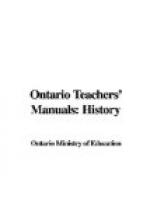Poems: Boadicea,
Cowper; Recessional, Kipling; Edinburgh After
Flodden, Aytoun;
Hands All Round, Tennyson; Columbus,
Joaquin
Miller; Waterloo,
Byron; The Armada, Macaulay; The Revenge,
Tennyson; The Charge
of the Light Brigade, Tennyson.
Prose: “United
Empire Loyalists,” Roberts’ History
of Canada,
Chap. XV; “Departure
and Death of Nelson,” Southey; Montcalm and
Wolfe, Parkman;
“The Crusader and the Saracen,” in Scott’s
The
Talisman; “The
Heroine of Castle Dangerous,” in Stories of
New
France, Machar and
Marquis; “Adam Daulac,” in Martyrs of
New
France, Herrington.
HISTORY AND SCIENCE
The connection between history and science is very close, because it was only after the invention of writing that history, the record of human progress, became possible. Further, the remarkable way in which the chief stages in the development of civilization coincide with certain inventions and discoveries makes the study of history very incomplete without a knowledge of the inventions and discoveries, inasmuch as these opened a road for human development. (See p. 119.)
To make this evident, it is enough merely to mention a few comparatively recent inventions, such as the mariner’s compass, the printing-press, gunpowder, the steam-engine, the power-loom, the cotton-gin, and the telegraph.
To the introduction of the mariner’s compass in the fourteenth century, by which sailors were made independent of landmarks and the stars, and could therefore go more boldly into the open sea, we owe the explorations of the fifteenth century that culminated in the discovery of America, and the way to India by the Cape of Good Hope. The introduction of gunpowder in the fourteenth century gave the lower and middle classes a weapon that made them equal in power with the nobles and brought about the downfall of the feudal system and the rise of modern democracies. The printing-press gave to the world the learning of the past and revolutionized social conditions. The invention of high explosives has made possible many of the great engineering works of to-day. The inventions that have made transportation and communication so easy and rapid have already done a great deal to bring nations to a better understanding of each other and thus to promote the peace of the world. Discoveries in medicine alone have had an incalculable influence on the health and prosperity of society. In fact, the study of history and an understanding of modern social and industrial conditions are impossible without a knowledge of scientific inventions and discoveries. (See pp. 87, 92.)
Children naturally take an interest in what individuals have done, and it is easy to interest them in the work of men such as Watt, Stephenson, Whitney, Fulton, Morse, Edison, Marconi, and their fellows. The biographies of famous inventors should therefore be given, both as a record of what they did and as an inspiration to like achievements.




